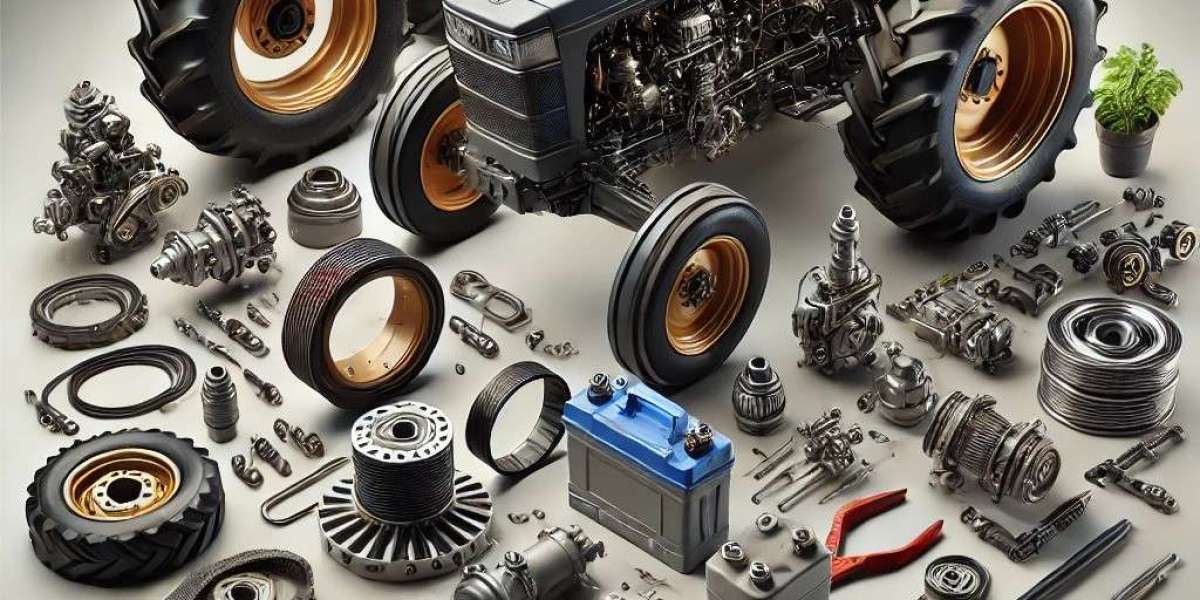Tractors are the backbone of farm operations, making them one of the most important investments for farmers. But like any piece of machinery, tractors can face issues over time. Fortunately, many common tractor problems can be fixed easily with the right knowledge and tools. Whether you're dealing with engine troubles, hydraulic issues, or electrical glitches, understanding some basic fixes for agricultural tractor parts can save you time and money.
In this guide, we'll walk you through some of the most common tractor problems and simple fixes that you can do yourself. These fixes will help keep your tractor running smoothly, so you can get back to the work that matters most.
Common Agricultural Tractor Parts Problems
Tractors are complex machines, and with so many moving parts, it’s inevitable that things can go wrong. Here are some of the most frequent issues that farmers encounter with their tractors:
Engine Won’t Start
- One of the most frustrating problems, especially in the middle of busy planting or harvest season, is a tractor that refuses to start.
Hydraulic System Malfunctions
- Hydraulic issues can prevent essential functions such as lifting, tilting, or controlling attachments.
Flat or Worn-Out Tires
- Tires take a lot of abuse, from rough terrain to heavy loads, and they can easily become damaged or flat.
Electrical Problems
- Electrical problems are common, especially with older tractors. These can range from faulty lights to malfunctioning alternators.
Overheating
- Overheating is a common problem that can lead to engine damage if not addressed quickly.
Clogged Fuel Filters
- A clogged fuel filter can cause a tractor’s engine to run roughly or not start at all.
Simple Fixes for Common Tractor Problems
Now, let’s dive into some practical solutions to keep your tractor running smoothly. Whether you’re a seasoned mechanic or a farmer just starting to work on your machinery, these simple fixes can help you troubleshoot and resolve common issues.
1. Fixing an Engine That Won’t Start
An engine that won’t start is a common problem, especially when tractors are left idle during the off-season.
Common Causes:
- Dirty fuel or clogged fuel filters.
- Dead battery or poor connections.
- Starter motor failure.
How to Fix It:
- Check the Battery: If the battery is dead or has weak connections, try jump-starting it or replacing the battery. Ensure that the terminals are clean and tightly connected.
- Inspect the Fuel System: Drain any old fuel and replace it with fresh fuel. If your fuel filter is clogged, it’s time to replace it. A clean filter ensures the engine gets the proper fuel flow.
- Test the Starter Motor: If the engine still doesn’t start after checking the fuel and battery, the starter motor might be faulty. Replace it if necessary.
2. Fixing Hydraulic System Malfunctions
Hydraulic systems are essential for controlling attachments like front-end loaders and plows. If the hydraulics aren’t working, your tractor becomes nearly useless for many tasks.
Common Causes:
- Low hydraulic fluid.
- Leaks in the hydraulic system.
- Air in the hydraulic lines.
How to Fix It:
- Check the Fluid Levels: Low hydraulic fluid is one of the most common causes of hydraulic failure. Top off the fluid and check for any leaks.
- Check for Leaks: Inspect the hydraulic lines and connections for leaks. If you find any, tighten them up or replace damaged hoses.
- Bleed the System: If there’s air in the hydraulic lines, bleed the system according to your tractor’s manual to restore proper pressure.
3. Repairing Flat or Worn-Out Tires
Flat or worn-out tires can hinder your tractor’s performance, making it difficult to move and potentially damaging the machine further.
Common Causes:
- Punctures from sharp objects.
- Worn tread from extensive use.
- Improper tire pressure.
How to Fix It:
- Check Tire Pressure: Ensure that the tires are inflated to the manufacturer’s recommended pressure. Low tire pressure can cause excessive wear and reduce traction.
- Fix Punctures: For small punctures, you can patch the tire or use a tire sealant to temporarily fix the issue. If the damage is severe, you may need to replace the tire.
- Replace Worn Tires: If the tread on the tires is worn down, it’s time to replace them. Worn-out tires can reduce traction and increase fuel consumption.
4. Solving Electrical Problems
Electrical issues are a nuisance and can lead to a variety of problems, from headlights not working to the tractor failing to start.
Common Causes:
- Blown fuses or faulty wiring.
- Dead battery or poor battery connections.
- Faulty alternator.
How to Fix It:
- Inspect the Battery and Connections: Clean any corrosion on the battery terminals and ensure all connections are tight. If the battery is old, replace it.
- Check the Fuses: If the tractor’s lights or electrical systems aren’t working, check the fuses and replace any that are blown.
- Test the Alternator: A faulty alternator can cause electrical problems. Test it with a multimeter and replace it if it’s not working properly.
5. Preventing Overheating
An overheating tractor can cause major engine damage if not addressed immediately. It’s important to regularly check the cooling system to ensure your tractor stays at the right temperature.
Common Causes:
- Low coolant levels.
- Dirty radiator.
- Broken or worn-out thermostat.
How to Fix It:
- Check Coolant Levels: Make sure the coolant is at the proper level. If it’s low, top it off with the appropriate coolant mixture.
- Clean the Radiator: A dirty radiator can prevent proper airflow, causing the engine to overheat. Clean the radiator regularly and remove any debris that might block airflow.
- Replace the Thermostat: If the engine continues to overheat, the thermostat may be faulty and needs to be replaced.
6. Fixing Clogged Fuel Filters
A clogged fuel filter can restrict fuel flow, causing your engine to run poorly or not start at all.
Common Causes:
- Dirty or contaminated fuel.
- Old or clogged filters.
How to Fix It:
- Replace the Fuel Filter: A clogged filter can often be fixed by simply replacing it. Ensure that you use the correct type of filter for your tractor.
- Use Clean Fuel: Always use clean, high-quality fuel to prevent contaminants from entering the filter. If you notice poor fuel quality, drain the fuel tank and replace it.
Conclusion
Dealing with tractor problems doesn’t have to be a stressful experience. By understanding some common issues and learning how to perform simple fixes, you can keep your agricultural tractor parts in good shape and minimize downtime on your farm. Regular maintenance and quick troubleshooting will ensure your tractor works efficiently and reliably for years to come.
Always remember to consult your tractor’s manual for specific instructions and maintenance schedules, and don’t hesitate to seek professional help if you’re unsure about any repair. Taking care of your equipment today can save you time, money, and effort tomorrow.







